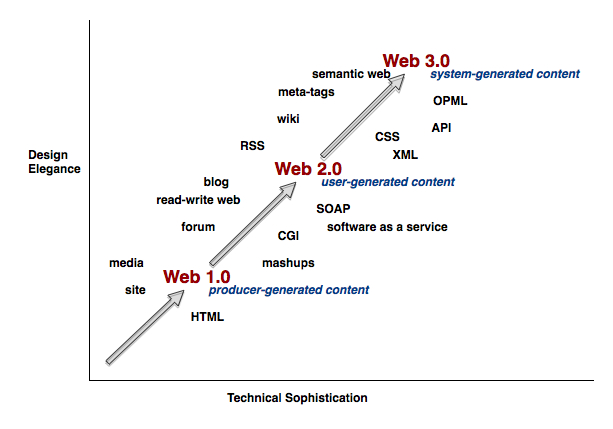In preparing for a talk I’m going to give, I was thinking about how to represent the trends from web 1.0 through 2.0 to 3.0. As I’ve mentioned before, in my mind 3.0 is the semantic web. I think of web 2.0 as really two things, the social read-write user-generated content web, and the web-services mashup web. In elearning, we tend to focus on the former, but the latter is equally important.
 However, if we think about web 2.0 as user-generated content, we can think about 1.0 as producer-generated content. The original web was what people savvy enough (whether tech or biz) could get up on the web. The new web is where it’s easy for anyone to get content up, through blogs, photo-, video-, and slide-sharing sites, and more.
However, if we think about web 2.0 as user-generated content, we can think about 1.0 as producer-generated content. The original web was what people savvy enough (whether tech or biz) could get up on the web. The new web is where it’s easy for anyone to get content up, through blogs, photo-, video-, and slide-sharing sites, and more.
Extending that, what’s web 3.0 going to be? If we take the semantic web concept, the reason we add these tags is for systems to start being able to use search and rules to find and custom-deliver content. An extension, however, is to have the system generate the necessary content (cf Wolfram|Alpha). In a sense, by knowing some things about you and your interests, needs, and activities, a system could proactively choose what and when to deliver information.
And that, to me, is really system-generated content, and a real opportunity. It’s not ahead of what we can do (though I recognize it’s ahead of where most are ready to be; why do you think it’s called Quinnovation? :), but it’s certainly something to keep on your radar. And when you’re ready, so am I!
Excellent visualization! Thank you for lending clarity to this incubation.
“a system could proactively choose what and when to deliver information. . . ” And presumably could do a certain amount of content *creation*. . if nothing else, juxtapositions of content that the user might not have considered? Really nice framework, Clark. Extra points if you can come up with cool labels for the axes of the graph!
Appreciate the feedback, though I have to confess that I was looking for a simplified version of this diagram, so I created my own.
So, Dan, you’ll see their axes are semantics of social/information connections (which I didn’t use, I was just scattering them along the line chronologically and then just for visual spacing!). So, I probably could’ve done it linearly, but I like the visual dynamics ;). I could rearrange and possibly have one dimension be technical sophistication and the other be design elegance (e.g. the original map that led to my performance ecosystem model). Hmm….now done.
I do claim that the notion of system-generated content is mine, at least I haven’t heard anyone else make that leap (and I searched and didn’t find anyone else mentioning it, though I don’t doubt but that they have). And, yes, I do believe content creation can go on, cf my reference to Wolfram|Alpha, which I think does do that. And more can be done. Thanks!